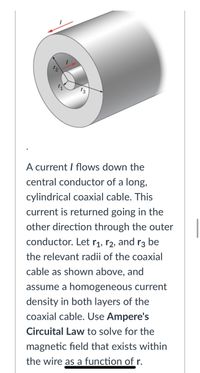Question
HINT: For both halves of this problem, make sure to consider the stronger magnetic field closer to the wire.

Transcribed Image Text:A current I flows down the
central conductor of a long,
cylindrical coaxial cable. This
current is returned going in the
other direction through the outer
conductor. Let rị, r2, and r3 be
the relevant radii of the coaxial
cable as shown above, and
assume a homogeneous current
density in both layers of the
coaxial cable. Use Ampere's
Circuital Law to solve for the
magnetic field that exists within
the wire as a function of r.
Expert Solution
This question has been solved!
Explore an expertly crafted, step-by-step solution for a thorough understanding of key concepts.
Step by stepSolved in 4 steps with 4 images

Knowledge Booster
Similar questions
- A proton moves in a uniform magnetic field as shown below. Find the direction of the force on the upward particle. O Up left To the right O To the left O Down O out of the page into the page right downward Barrow_forwardA wire carries an I, = 7.05-A current along the x-axis, and another wire carries an I, = 5.35-A current along the y-axis, as shown in the figure below. What is the magnetic field at point P, located at x = 4.00 m, y = 3.00 m? magnitude HT direction Select--- y (4.00, 3.00) marrow_forward(Figure 1) shows a mass spectrometer, an analytical instrument used to identify the various molecules in a sample by measuring their charge-to- mass ratio q/m. The sample is ionized, the positive ions are accelerated (starting from rest) through a potential difference AV, and they then enter a region of uniform magnetic field. The field bends the ions into circular trajectories, but after just half a circle they either strike the wall or pass through a small opening to a detector. As the accelerating voltage is slowly increased, different ions reach the detector and are measured. Consider a mass spectrometer with a 200.00 mT magnetic field and an 8.0000 cm spacing between the entrance and exit holes. igure + AV d Detector Part A To five significant figures, what accelerating potential difference AV is required to detect the ion O,? The masses of the atoms are shown in the table; the mass of the missing electron is less than 0.001 u and is not relevant at this level of precision. Use…arrow_forward
- Four separate configurations of current-carrying wires are shown. All points are equidistant with respect to the wires. At which point is the magnitude of the magnetic field the greatest?arrow_forward(d) Describe the Earth's magnetic field and include a diagram. (e) Why do parallel currents attract? Include a diagram that shows the magnetic field and magnetic force of the first wire on the second wire.arrow_forwardAssume this page is perpendicular to a uniform magnetic field and the magnetic flux through it is 5Wb. If the page is turned by 30◦ around an edge, the flux through it will become: (2.5Wb, 4.3Wb, 5Wb, 5.8Wb, 10Wb.)arrow_forward
- At the equator, near the surface of the Earth, the magnetic field is approximately 50.0 µT northward, and the electric field is about 100 N/C downward in fair weather. Find the gravitational electric, and magnetic forces on an electron in this environment, assuming that the electron has an instantaneous velocity of 5.00 x 10° m/s directed to the east. gravitational force N directed ---Select--- v electric force N directed ---Select--- ♥ magnetic force N directed ---Select--- varrow_forwardA oxygen ion with a -2 charge is traveling in the +z direction. It enters a region of uniform magnetic field that points to the -y direction. When the ion enters this region, which direction will it be deflected?arrow_forward
arrow_back_ios
arrow_forward_ios